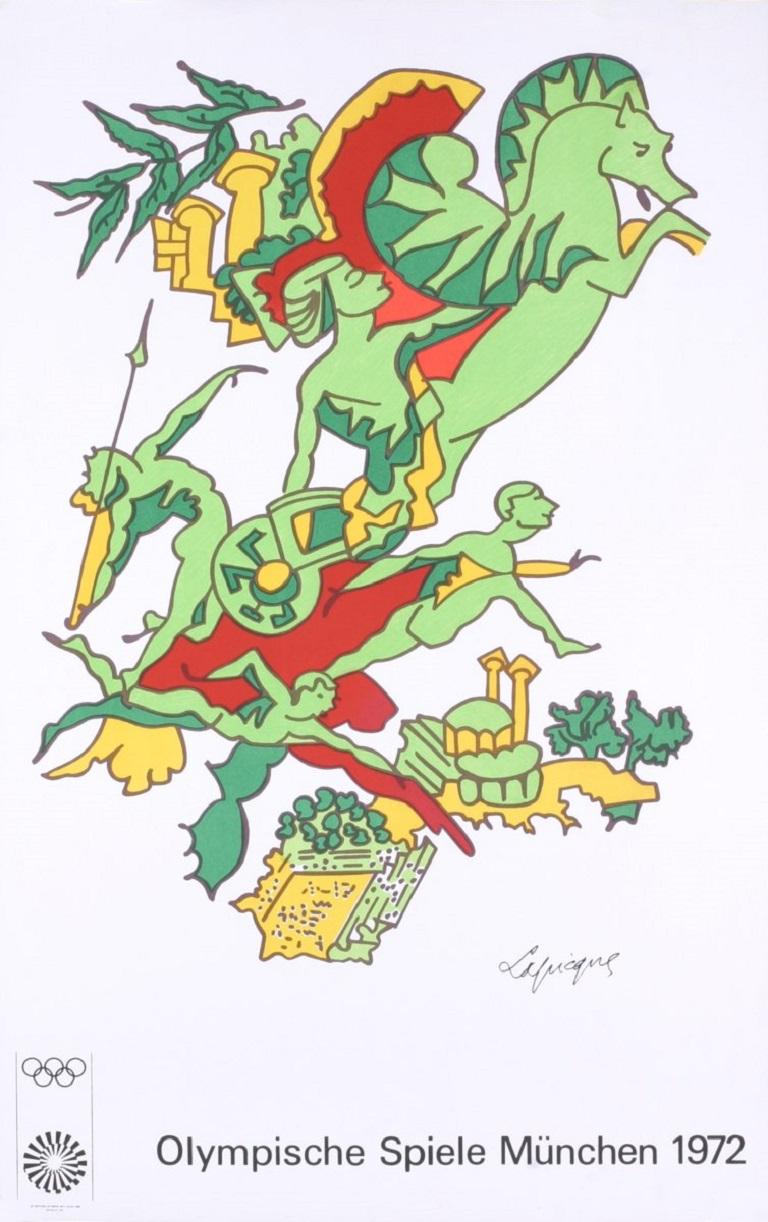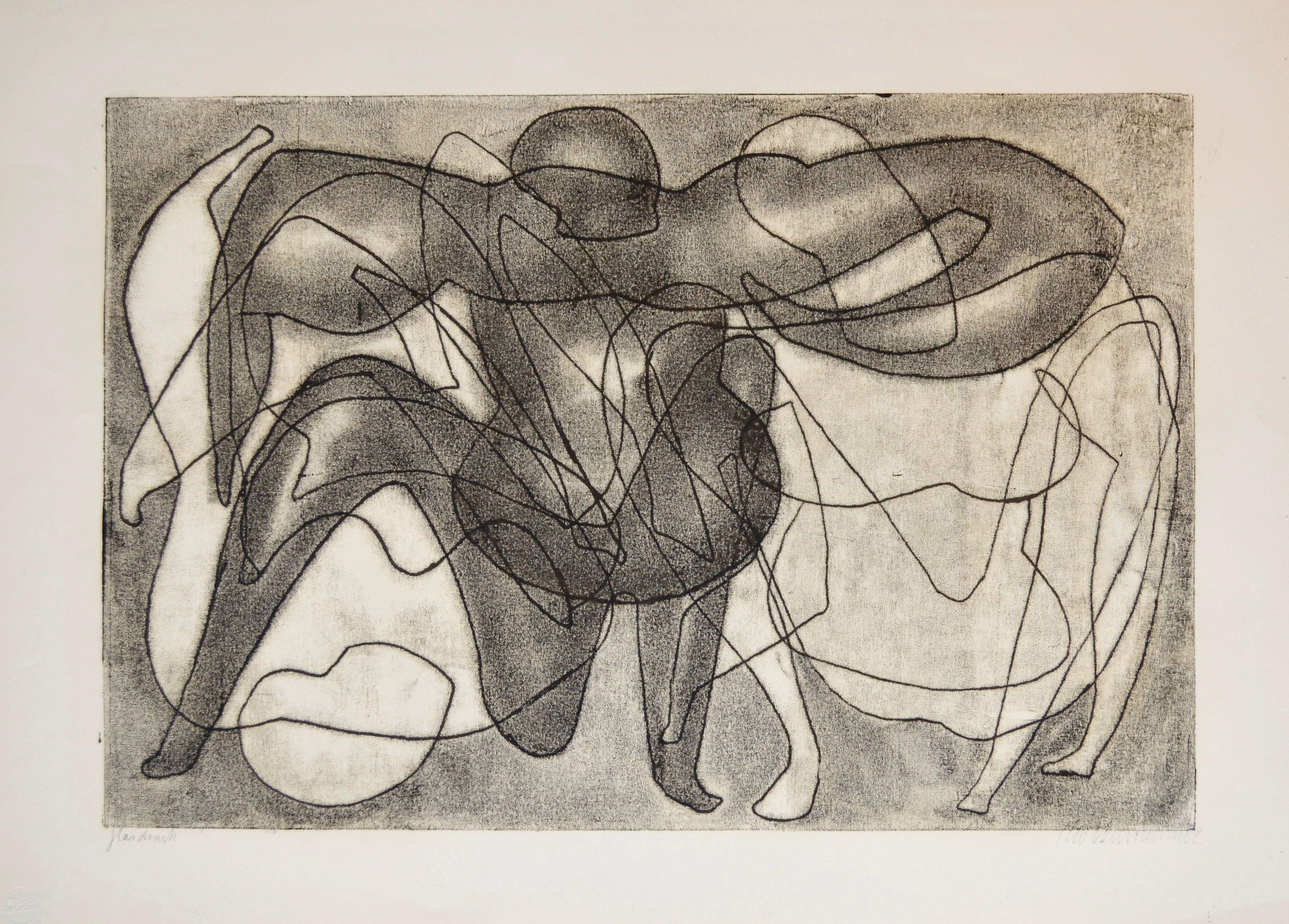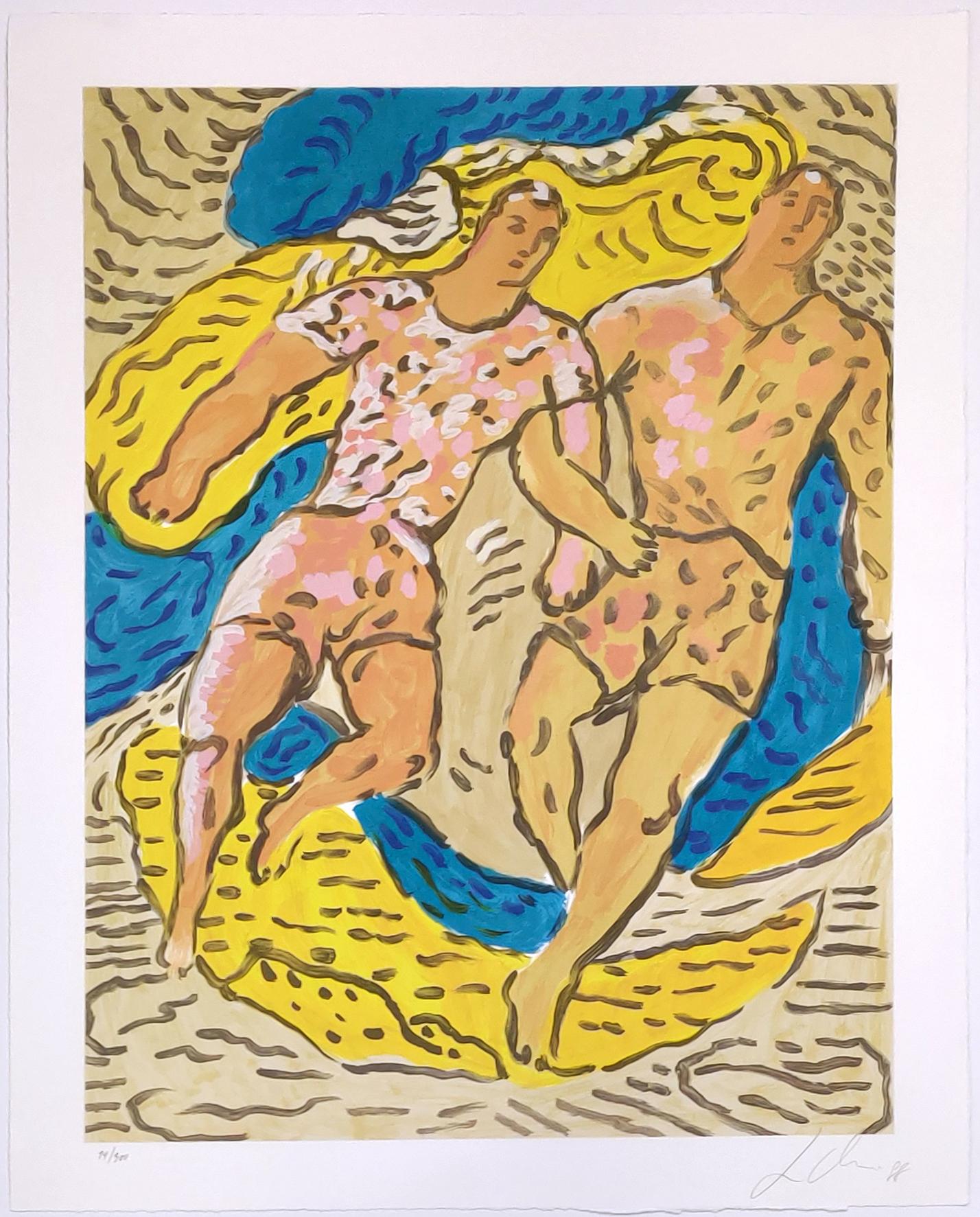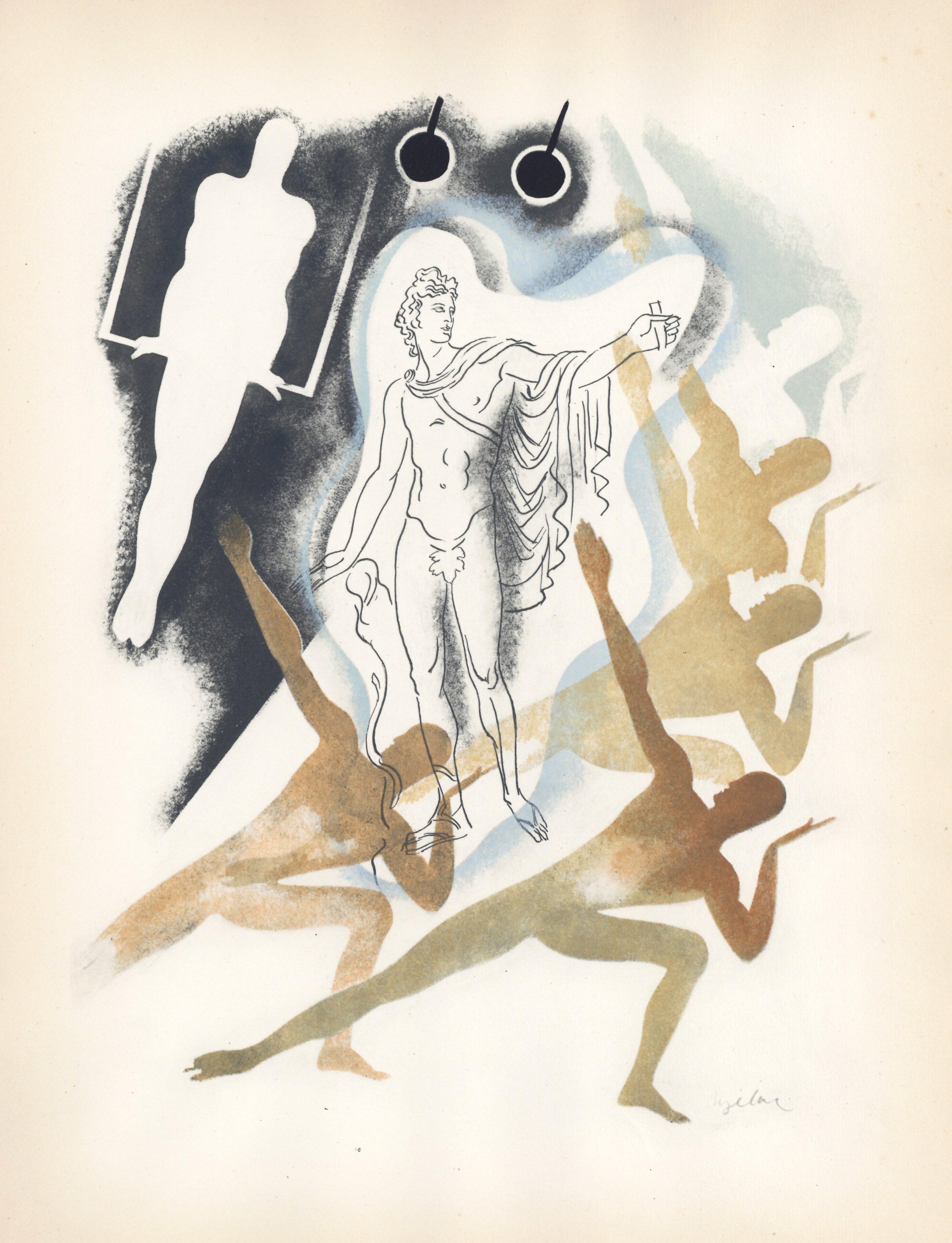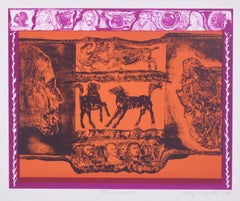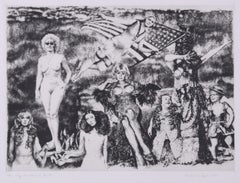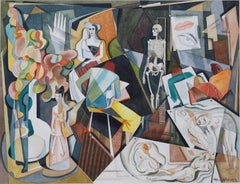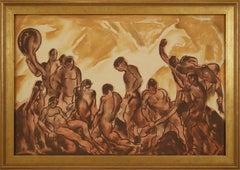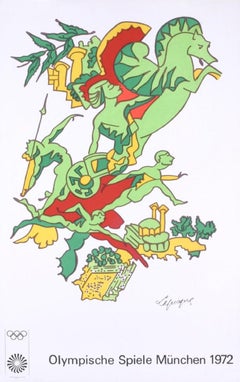Items Similar to Olympian Games
Want more images or videos?
Request additional images or videos from the seller
1 of 11
Ray H. FrenchOlympian Games1957
1957
$1,750
£1,366.89
€1,549.53
CA$2,508.82
A$2,752.04
CHF 1,439.91
MX$32,754.75
NOK 18,186.94
SEK 17,059.67
DKK 11,572.77
About the Item
Olympian Games
Engraving, 1957
Signed, dated, titled and numbered (see photos)
Edition: 25 (7/25)
From the first and only edition, probably less than 8 impressions printed
Printed by the artist
Condition: Excellent
soft fold in upper left margin
Image size: 15 7/8 x 19 7/8 inches
Sheet size: 18 1/2 x 22 3/8 inches
Provenance: Estate of the artist
Martha A. French Revocable Trust
Item Reference
LU14013763732
Crucifixion, color etching, 1947
Item Reference
LU14013160582
The Web, engraving, 1950
Item Reference
LU14011892032
The Swan, mixed media (etching & soft ground), 1957
Item Reference
LU1404294651
Snowy Egret, engraving, 1954, third edition c. 1990, printed by the master printer Jon Clemens
Item Reference
LU1402253433
Debris, color etching, c. 1940, printed by the artist at the John Herron Art Institute, Indianapolis, Indiana
Item Reference
LU140331242
Crucifixion, engraving, 1958
Item Reference
LU140145330
Strange Animals, engraving, 1947
Item Reference
G130708140172
The Gull, engraving, 1955
Item Reference
LU14012448972
Moon Rays, graphic construction, 1967
Moon Rays
Graphic Construction (three sheets layered in a shadow box presentation), 1967
Signed lower right. Editioned lower left. (see photos)
Edition: 60 from the second printing c. 1990 (see photo)
Presented in a black wooden frame with a three level archival presentation with OP3 Acrylic
Frame size: 31 1/4 x 23 1/4 inches
In the 1960s, Ray also started to focus on blind embossing, which he had first experimented with at the University of Iowa. He was extremely prolific and successful with this medium, selling hundreds of prints in small editions of 10 through the Associated American Artist Gallery in New York. In 1966, Ray built upon his mastery of embossing and began developing a shadow box presentation called a graphic construction that combined color, blind embossing, and multi-layered cutouts to revel embossed intaglio compositions. Noted curator William Lieberman purchased Ray’s masterpiece graphic construction, Moon Rays, on the behalf of MOMA New York and another impression was gifted to the University of Iowa Museum of Art by Alan and Ann January in 2004.
Note: An impression of this image was purchased by William Lieberman for the collection of the Museum of Modern Art, New York. (See MOMA paperwork in photos)
Ray H. French: The Evolution of an Artistic Innovator
Printmaker, painter, and sculptor Ray H. French was born in Terre Haute, Indiana on May 16, 1919. Terre Haute was a cultural wasteland before the opening of the Sheldon Swope Art Museum in 1942. Thus, with a father as a coal miner and carpenter, art remained a luxury for Ray. Nevertheless, local art teachers Mabel Mikel Williams and Nola E. Williams helped to foster his creativity and unshakable drive to create things of beauty.
After high school, Ray attended the John Herron School of Art in Indianapolis. His studies there were interrupted by the outbreak of World War II, during which he developed surveillance photographs for the Army Air Force. After the war, Ray transferred to the University of Iowa on the G.I. Bill, where he received both his BFA and MFA degrees. The University of Iowa during the 1940s was a cultural mecca with many major art historians and artists. While in Iowa, Ray played an important role in this culture by becoming a founding member of the Iowa Print Group under Mauricio Lasansky.
Following his graduation in 1948, Ray experienced firsthand the rapid rise in creative printmaking in America. By 1949, he had exhibited at The Brooklyn Museum, the Walker Art Center, and MOMA New York. Ray’s early style of printmaking is characterized by pure line engraving on copper plates, a technique suited perfectly to his study of the beauty of animals. This charming and whimsical subject ran counter to the concurrent trends of Lasansky’s horrors of war and Hayter’s non-objectivity, but was equally effective in capturing the public’s attention. Walruses was purchased by the Victoria and Albert Museum, exhibited at MOMA New York and received the Arthur D. Allen Memorial Purchase Prize for its “skillful and economic use of line.” Shortly thereafter, Ray’s treatment of animals developed further into larger format mixed intaglio prints utilizing hard ground, soft ground, etching, and engraving, as exemplified in The Swan.
By the late 1950s, Ray’s style evolved into organic non-objectivity, in which he incorporated personal autobiographical vignettes and symbolism. His work during this time was further characterized by a departure from the traditional squared compositional format to his cutting and rounding of the plate to accentuate organic shapes. Ray’s 1959 Enchantment remains particularly illustrative of his use of etching and soft ground intaglio. Enchantment was successfully exhibited at the Brooklyn Museum of Art for the 12th National Print Exhibition of The American Federation of the Arts and received the Pennell Purchase Prize from the Library of Congress in 1960.
In the 1960s, Ray also started to focus on blind embossing, which he had first experimented with at the University of Iowa. He was extremely prolific and successful with this medium, selling hundreds of prints in small editions of 10 through the Associated American Artist Gallery in New York. In 1966, Ray built upon his mastery of embossing and began developing a shadow box presentation called a graphic construction that combined color, blind embossing, and multi-layered cutouts to revel intaglio compositions. Noted curator William Lieberman purchased Ray’s masterpiece graphic construction, Moon Rays, on the behalf of MOMA New York and another impression was gifted to the University of Iowa Museum of Art by Alan and Ann January in 2004.
Throughout his artistic career, Ray was also a professor and administrator at DePauw University, which occupied much of his time. Outside of his creative expression, Ray was most proud of his teaching and influencing students to find beauty in their daily lives. Specifically, he was a particularly fervent advocate of printmaking and joined the ranks of many of Lasansky’s students who went on to establish printmaking programs and departments and to further lift the stature of intaglio printmaking. During Ray’s time at DePauw, he received grants to travel around Europe. His yearlong stay in Florence led to a series of etchings, drypoints, and woodcuts of Italian and Etruscan subjects and provided inspiration for many years.
In 1984, Ray retired from his university service to work in a private studio behind his home on DePauw’s campus. After several life threatening illnesses, Ray decided to return to his early creative style of realist depictions of nature and landscape. Eventually, Ray’s health deteriorated further with the onset of macular degeneration. Legally blind, he continued to create art until shortly before his death in 2000 at the age of 80. “Sometimes when I look at a work I create, I am amazed at what inspired it. I ask myself, how on earth did I create this?” said Ray once. Ultimately, this quest to find beauty and create inspiring works of art provided the greatest source of Ray’s happiness and fulfillment, evidenced by the breadth and quality of his artistic legacy.
- Creator:Ray H. French (1919-2000, American)
- Creation Year:1957
- Dimensions:Height: 15.88 in (40.34 cm)Width: 19.88 in (50.5 cm)
- Medium:
- Movement & Style:
- Period:
- Condition:
- Gallery Location:Fairlawn, OH
- Reference Number:Seller: RHF00231stDibs: LU14013793612
About the Seller
5.0
Recognized Seller
These prestigious sellers are industry leaders and represent the highest echelon for item quality and design.
Gold Seller
Premium sellers maintaining a 4.3+ rating and 24-hour response times
Established in 1978
1stDibs seller since 2013
826 sales on 1stDibs
Typical response time: <1 hour
Associations
International Fine Print Dealers Association
- ShippingRetrieving quote...Shipping from: Akron, OH
- Return Policy
More From This Seller
View AllTurn-about
By Rudy O. Pozzatti
Located in Fairlawn, OH
Turn- about
Color Aluminum plate lithograph from three plates
Signed, titled, and numbered in pencil by the artist
"Bon-a-tirer" impression (BAT)
This is the finished example that the artist approved as the model for the edition.
Published at Lakeside Studio with the master printer Jack Lemon.
Condition: Very good, one ink stain in the large margin, from printing
Image size: 18 3 /4 x 23 1/4" 47.63 x 59.06cm
Sheet size: 22 x 29 7/8"
"Painter and printmaker Rudolph Otto "Rudy" Pozzatti was born in Telluride, Colorado, on January 14, 1925. Upon graduation from high school, he received a scholarship to attend the University of Colorado in Boulder where he enrolled as an art major. In 1943, his studies were interrupted by his induction into the U. S. Army. After his discharge in 1946, he re-enrolled in the University of Colorado where he studied under Wendell Black...
Category
1970s American Modern Prints and Multiples
Materials
Lithograph
The Web
By Ray H. French
Located in Fairlawn, OH
The Web
Engraving and soft ground, 1950
Signed, titled, dated and numbered by the artist
Edition: 35 (26/35)
Printed by Master Printer, Jon Clemens, 2000
Provenance:
Estate of the ar...
Category
1950s Surrealist Figurative Prints
Materials
Engraving, Etching
My Bicentennial Print
By Herbert L. Fink
Located in Fairlawn, OH
My Bicentennial Print
Photo etching, 1976
Signed and dated in pencil lower right (see photo)
Titled and numbered in pencil loer left (see photo)
Edition: 21 (16/21) There also appears to be an additon of 100.
Condition: Excellent
Image/Plate size: 14 1/2 x 19 3/4 inches
Sheet size: 22 1/8 X 30 inches
The artist's commentrary on the Bicentennial Year of 1976
In 1965 Fink was awarded a Gugenheim Memorial Foundation Fellowship for Fine Arts.
Herbert Lewis Fink, painter, printmaker, sculptor, and educator, born was in Providence, Rhode Island on September 8, 1921. He studied at the Carnegie Institute of Technology in 1941, he received is B.F.A. degree from the Rhode Island School of Design in 1949, his M.F.A. from Yale University in 1956, and he also studied for a year at the Art Students League and with John Frazier...
Category
1970s Contemporary Nude Prints
Materials
Etching
The Model
By William C. Grauer
Located in Fairlawn, OH
The Model
Watercolor on paper, c. 1930
signed lower right (see photo)
Condition: Excellent
A few bits of adhesive residue verso
Colors fresh and unfaded
Housed in a Marin style meta...
Category
1930s American Modern Interior Drawings and Watercolors
Materials
Watercolor
Female Nude Study
By William Sommer
Located in Fairlawn, OH
Female Nude Study
Graphite and crayon on wove paper, c. 1928
Signed with the Estate stamp "B" (see photo)
Provenance: Estate of the Artist
Edward Sommer (his so...
Category
1920s American Modern Nude Drawings and Watercolors
Materials
Crayon
Jedermann
By Ray H. French
Located in Fairlawn, OH
Etching in two colors
Signed, dated, titled in pencil by the artist
Sheet size: 19 5/8 x 25 3/4"
Category
1950s Abstract Prints
Materials
Etching
You May Also Like
The Struggle, Early 20th Century Figural Group
Located in Beachwood, OH
August Frederick Biehle (1885-1979)
The Struggle, c. 1936
Pastel and graphite on illustration board
Unsigned
17 x 26 inches
20 x 28.5 inches, framed
Provenance: from the estate of Au...
Category
1930s American Modern Figurative Drawings and Watercolors
Materials
Pastel, Graphite
1972 Charles Lapicque 'Olympics 1972'
By Charles Lapicque
Located in Brooklyn, NY
Paper Size: 40.25 x 25.25 inches ( 102.235 x 64.135 cm )
Image Size: 32 x 23 inches ( 81.28 x 58.42 cm )
Framed: No
Condition: A: Mint
Additional Details: Official poster desig...
Category
1970s Contemporary Prints and Multiples
Materials
Lithograph
$100 Sale Price
20% Off
Strong Girl
By Walt Kuhn
Located in New York, NY
Walt Kuhn (1877-1949), Strong Girl, drypoint, 1916 [signed in pencil by Kenneth Hays Miller and inscribed “Zinc sheet E printed by Howard Moore Park 1928”). In very good condition, printed on a cream wove paper, 7 1/2 x 5 1/4, the sheet 11 1/8 x 8 1/2 inches.
Provenance: ex Collection: The Metropolitan Museum of New York, with their stamp verso.
ex Coll: Jonathan Greenberg, New York City
A very good impression of this rare early Kuhn print.
This is listed as number 48 in the Kennedy Galleries Walt Kuhn Checklist, made for an exhibit of his prints in 1967; it is cited as a print where no more than 6 impressions are known to exist.
Kuhn was of course intimately familiar with circuses and carnivals...
Category
1910s American Modern Figurative Prints
Materials
Drypoint
Estate No. 063062
By Otto Neumann
Located in New Orleans, LA
Otto Neumann (1895-1975) was an expressionist painter and printmaker born in Heidelberg, Germany. He was one of the most versatile and original artists of the twentieth century. Neum...
Category
1960s Expressionist Figurative Prints
Materials
Monotype
OLYMPIC ATHLETES
By Sandro Chia
Located in Aventura, FL
Lithograph in colors on paper. Hand signed and numbered by the artist. Published by Circle Fine Arts Ltd., Chicago, IL. Printed by American Atelier, NY on Somerset Paper. Edition...
Category
1980s Contemporary Figurative Prints
Materials
Paper, Lithograph
$637 Sale Price
50% Off
"La Gymnastique" pochoir for Les Joies du Sport
By Milivoy Uzelac
Located in Henderson, NV
Medium: pochoir. Printed in Paris in 1932 on Velin du Marais paper at the atelier of Daniel Jacomet for the Les Joies du Sport portfolio and issued in an edition of 750. This was pub...
Category
1930s Prints and Multiples
Materials
Lithograph, Stencil
More Ways To Browse
Photo Vintage France
Copper Engraving Plate
Etchings Of Italy
Large Intaglios
Gilot Signed
Henri de Toulouse-Lautrec On Sale
Henri Matisse Danseuse
Henry De Groux
Hogarth Etching
Iwo Jima
Jacques Jacob
Jean De Paleologue
Jim Dine Dorian
John Buckland Wright
Journal Des Demoiselles
Kathe Kollwitz Etchings
Kees van Dongen On Sale
Keith Haring Eye

